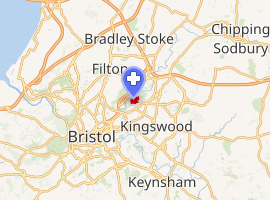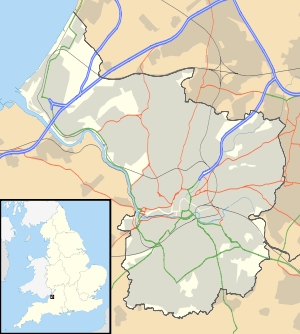Blackberry Hill Hospital
Blackberry Hill Hospital is an NHS psychiatric hospital in Fishponds, Bristol, England, specialising in forensic mental health services,[1] operated by the Avon and Wiltshire Mental Health Partnership NHS Trust. The hospital also offers drug and alcohol rehabilitation inpatient services,[2] and is the base for a number of community mental health teams.[3]
| Blackberry Hill Hospital | |
|---|---|
| Avon and Wiltshire Mental Health Partnership NHS Trust | |
 The clock tower and grey stone buildings of Blackberry Hill Hospital can be seen in the middle distance | |

| |
 Location within Bristol | |
| Geography | |
| Location | Bristol, United Kingdom |
| Coordinates | 51.484853°N 2.540725°W |
| Organisation | |
| Care system | Public NHS |
| Type | Psychiatric hospital |
| Services | |
| Emergency department | No Accident & Emergency |
| History | |
| Opened | 1779 |
| Links | |
| Lists | Hospitals in the United Kingdom |
Opened as a prison in 1779, many of its buildings and the co-located Glenside campus of the University of the West of England (UWE) are Grade II listed. From 1948 until 2005, the site was also a geriatric hospital, for many of those years being the major geriatric hospital in South West England. In 2009, 21 acres (8.5 ha) of the site, incorporating the oldest buildings, was sold to the UK Government's Homes and Communities Agency, and is proposed to be redeveloped as part of a wider regeneration project.
History
Stapleton Prison

The site first came into use as a prison in 1779,[4] during the American Revolutionary War, when it was developed to house Dutch and Spanish prisoners of war who had been landed at Bristol Docks. After George III recognised the 13 United States of America as free and independent in 1783, the prisoners were sent home.[5]
The site formally adopted the title 'Stapleton Prison', but was under utilised in civilian use, and was again expanded from 1793 after the commencement of the Napoleonic Wars. A third prison building was completed in 1804, used most recently as nurses' accommodation. After the Treaty of Paris of 1814, the prisoners were again repatriated.[5]
Writing in London Labour and the London Poor, published in 1862, Henry Mayhew recounted a letter sent by the secretary of the Bristol Society for the Suppression of Vice in 1808: 'Sir, I took my horse and rode to Stapleton prison ... Inclosed are some of the drawings which I purchased in what they call their market ... They wished to intrude on me a variety of devices in bone and wood of the most obscene kind ... I purchased a few, but they are too bulky for a letter. This market is held before the door of the turnkey every day between the hours of ten and twelve.’[6]
Stapleton Workhouse
Used as a naval stores, and then a school for naval boys, after a cholera outbreak in 1834 led to overcrowding of Bristol's first workhouse at St Peter's Hospital, the Bristol Corporation of the Poor rented the old prison.[5] After purchasing the site in 1837, they began to make alterations, adding to the walls separating the different sections of the site. In 1861, they demolished many of the oldest prison buildings, and built the main structure of what later become Blackberry Hill Hospital.[5] On the 1880 Ordnance Survey map it is shown as the Bristol Union Workhouse.[7]
Stapleton Institution
At the start of the First World War, the site was turned over to become Stapleton Institution for the Maintenance and Workshop Training of Certified Mental Defectives. The facility housed and then trained those assessed as mentally defective in domestic and industrial crafts, so that they could be deployed in the war effort. After the end of hostilities, these housing and post-assessment training activities continued.[5]
Stapleton Hospital
After the Second World War, the National Health Service Act 1946 turned the informal retention activity into a full mental health facility, under the title Stapleton Hospital. Records show that on take over by the NHS, the facility was caring for 837 patients: 350 under the Mental Treatment Act 1930; 152 mentally handicapped; 80 social misfits. Even after takeover, the previous regime stayed in place, with patients assessed as capable enough working for their keep in the hospital's kitchens, bakery and for local farms.[5] However, in 1948 it became Stapleton Hospital for Geriatric Illness.[4][8]
Manor Park Hospital
Renamed under the NHS reforms of 1956, Manor Park Hospital retained its geriatric illness brief.[4] The hospital was staffed by eight consultancy teams, and much of its workhouse related architecture was removed, reducing ward sizes, and replacing farming and work areas with gardens.[5][9] In the 1960s Manor Park Hospital was the major geriatric hospital in South West England. Patient turnover rose despite bed numbers gradually declining from about 650, to about 430 in 1977, due to length of stays decreasing.[10]
Blackberry Hill Hospital
From January 1993, the hospital site merged with the adjacent Glenside Hospital, originally built as a lunatic asylum, to become the jointly named Blackberry Hill Hospital. Patients of Glenside were assessed for capability, with many placed within the Care in the Community programme, while the residual were moved into new buildings constructed on the former Manor Park site for their long term care.[5][11]
Geriatric services
Geriatric services were initially run by the Frenchay Healthcare Trust, which took in patients from a wide area. In 1997, the newly created North Bristol NHS Trust (NBT), merging the operations of Frenchay Hospital and Southmead Hospital, took over the running of these services and focused on patients from the trust catchment area.[12][13]
In June 2005, NBT closed inpatient services at Blackberry Hill Hospital, transferring most services to Frenchay Hospital and Southmead Hospital, with the objective of improving services while reducing costs. Stroke services, orthopedic rehabilitation services, dementia services and intermediate care services were moved from Blackberry Hill Hospital.[13]
A small respite care service was transferred to Thornbury Hospital.[13] Associated with the move, an inpatient service for elderly mental health patients run by Avon and Wiltshire Mental Health Partnership Trust (AWP) at Blackberry Hill was enlarged in size.[13][14] Some geriatric outpatient services remained at the site, including the Memory Service. However, in 2006 AWP took over the running of the Memory Service, following the national model of Mental Health Trusts running this service.[12] A charity for research into Alzheimer's disease, BRACE, and the Regional Quality Control Laboratories continued to use the site under a lease from NBT until July 2010.[15]
Psychiatric services
In 2005, AWP created, two new secured facilities at Blackberry Hill. The first was a refurbishment of the secure in-patient care facility to create the Wickham Unit (or Wickham Low Secure Service). The second in new buildings to the rear of the site provided a medium secure facility, known as Fromeside (or Fromeside Medium Secure Unit).[5][16][17]
In 1996, the Avon and Gloucestershire College of Health (along with the Bath and Swindon College of Health Studies) became part of the University of the West of England (UWE), and the Glenside site became the UWE Faculty of Health and Social Care.[18] In 2013, AWP was given a formal warning by the Care Quality Commission over low staffing levels at its medium-secure unit on the site.[19]
Redevelopment
In 2005, North Bristol NHS Trust transferred most of their remaining services to Frenchay and Southmead Hospitals. In 2007, they declared the Blackberry Hill site surplus to requirements, while AWP moved some of its older people services to Callington Road and Southmead hospitals. After transferring their 10% interest in the site to NBT, AWP adult mental health services were moved to the most modern buildings at the rear of the hospital site.[15]
In 2009, the residual 21 acres (8.5 ha) Blackberry Hill site was sold to the UK Government's Homes and Communities Agency to be redeveloped as part of a wider regeneration project. The buildings which are mainly Grade II listed will be converted into a mixed-use development of flats, houses, shops and small business premises.[20] In 2017, it was announced that 346 houses would be built on the site.[21]
See also
References
- "Fromeside Secure Services". Avon And Wiltshire Mental Health Partnership NHS Trust. AWP. Retrieved 7 February 2015.
- "Detoxification and Stabilisation - Acer Unit". Avon And Wiltshire Mental Health Partnership NHS Trust. AWP. Retrieved 7 February 2015.
- "Services At Blackberry Hill". Avon And Wiltshire Mental Health Partnership NHS Trust. AWP. Retrieved 7 February 2015.
- "A history of the city's mental institutions from 1698". Bristol Evening Post. 19 June 2011. Archived from the original on 5 May 2013. Retrieved 25 February 2012.
- "Blackberry Hill Hospital". BBC West. Retrieved 14 April 2011.
- "London Labour and the London Poor". Victorian London. Retrieved 22 September 2018.
- "Eastville And Stapleton Workhouses". Bristol Radical History Group. 10 February 2015. Retrieved 25 June 2015.
- J. Jancar (11 August 1987). "The History of Mental Handicap in Bristol and Bath" (PDF). Psychiatric Bulletin. 11 (8): 261–264. doi:10.1192/pb.11.8.261. Retrieved 25 February 2012.
- "Manor Park Hospital, Bristol, England". Parks and Gardens UK. 24 January 2008. Retrieved 31 January 2015.
- Martin Gorsky (February 2013). "'To regulate and confirm inequality'? A regional history of geriatric hospitals under the English National Health Service, c.1948-c.1975" (PDF). Ageing and Society. Cambridge University Press. 33: 598–625. doi:10.1017/S0144686X12000098. Retrieved 30 January 2015.
- R. W. K. Reeves (1993). "The last dance" (PDF). Psychiatric Bulletin. 17: 293. doi:10.1192/pb.17.5.293. Retrieved 3 February 2015.
- Dr Judy Haworth (September 2007). "Newsletter - Memory Services in the Bristol area" (PDF). Bristol Research Into Alzheimer's and Care of the Elderly. Archived from the original (PDF) on 8 February 2015. Retrieved 8 February 2015.
- Report to Joint Health Scrutiny Committee - Blackberry Hill Hospital Project: Post Project Evaluation (PDF) (Report). Bristol City Council. 20 July 2006. Archived from the original (PDF) on 8 February 2015. Retrieved 8 February 2015.
- "Patients moved from mental unit". BBC. 11 September 2007. Retrieved 8 February 2015.
- "Former Bristol hospital could be turned into houses". thisisbristol.co.uk. June 5, 2009. Archived from the original on September 14, 2012. Retrieved 14 April 2011.
- Richard Prior (April 2010). Fromeside - Developing Safe and Secure Mental Health Services (PDF) (Report). Bristol City Council. Archived from the original (PDF) on 30 January 2015. Retrieved 30 January 2015.
- Avon and Wiltshire Mental Health Partnership NHS Trust - Forensic and Secure Services Quality Report (PDF) (Report). Care Quality Commission. 18 September 2014. Retrieved 30 January 2015.
- "UWE history timeline". University of the West of England. Retrieved 3 February 2015.
- "Avon and Wiltshire Mental Health Trust given formal warning". BBC. 8 February 2013. Retrieved 10 November 2013.
- "Former Blackberry Hill Hospital in Bristol purchased". Homes and Communities Agency. June 5, 2009. Archived from the original on 4 April 2011. Retrieved 14 April 2011.
- "Blackberry Hill Hospital to be turned into 346 new homes - and 100 will be 'affordable'". Bristol Post. 6 July 2017. Retrieved 22 September 2018.
